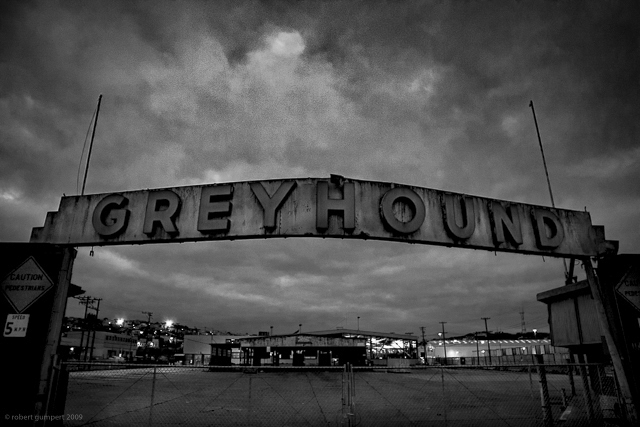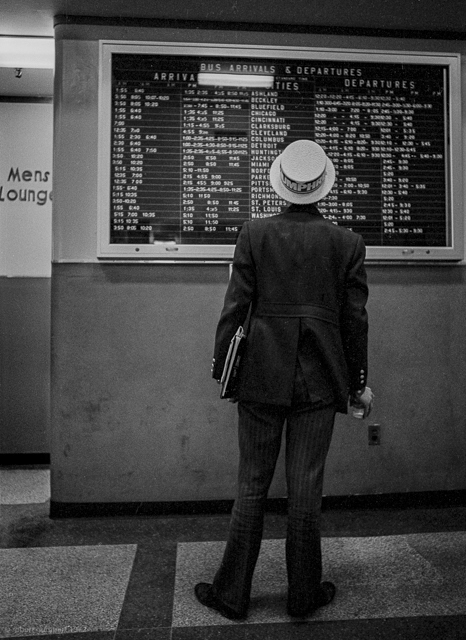Traveling Grey Dog Style
By Nelson Perez-Olney
In mid July I packed a small backpack with 4 days worth of clothes and hopped aboard a plane to Dallas. I was beginning a two-week tour of the Deep South, my first ever trip to that part of the country. The plan, if it can be labeled such, was to arrive in Dallas and from there zigzag from city to city, spending a few days here and there until I reached Atlanta where I’d catch a flight home to San Francisco. I wanted to see the land of slavery, the civil war, Jim Crow, and civil rights. I wanted to see the states that figured into the worst stereotypes of American backwardness. I wanted either to challenge or affirm my notions of our southern neighbors.
Riding the Greyhound from city to city provided two advantages. The first was extreme practicality. I don’t think any other mode of transportation could have provided the type of flexibility and frequency of service that my plan required. The Greyhound, unlike airlines, trains, or even other bus lines, stops almost everywhere, and it does so at a very low price.
The second advantage was the feeling of actually having put in the miles. There is no “flying over” when you’re riding the Greyhound. I wanted to travel through the South, not over it. I didn’t want to limit my experience to just the cities. I wanted to see Texas flatlands, Tennessee woods, Louisiana swamps and wetlands, houses in the middle of nowhere, confederate flag bumper stickers and prolife billboards.
Some of my friends thought I was crazy. To them a Greyhound trip was a dangerous undertaking. Crazies ride the Greyhound. Someone might cut my head off while I slept. Others thought it would be a cool adventure; romantic in the way a cross-country motorcycle road trip is romantic, full of quiet insights and spectacular sunsets. I admit to feeling a mixture of their concern and excitement. Before leaving I wrote out a list of all the bad things that could happen to me in the middle of nowhere on a bus (dismemberment made the list). At the same time, I felt small stirrings of pride whenever anyone asked me what the hell I was thinking, crazy bastard.
I never lost my head and the only sunrise I saw hurt my sleep-deprived eyes. But the plan worked beautifully. I visited 9 cities in 18 days, and touched ground in every Deep South state except Florida. I saw plantations and battlefields, civil rights memorials, sites of tragic importance. I heard jazz bands in the street and got stuck in four torrential rainstorms. I saw a giant Trump billboard (only one). I even met a Buddhist gun enthusiast. And I was granted a few little insights.
But they didn’t come easy.
Selling Points
I would never recommend a southern Greyhound tour to anyone unless they are seriously committed to boredom and discomfort for a large portion of their vacation. Don’t get me wrong, it suited my purpose wonderfully, but I had already resigned myself to misery before I boarded my first bus. Let me explain.
The Greyhound is slow. The drivers have lead feet and fly down the highways and around turns at speeds that draw your attention to the bus’s top-heavy construction, but they still have to contend with traffic. Also they stop every 100 miles or so to pick up and drop off passengers. There is no copilot who can take over when the driver hears nature’s call. Oh, and god forbid your bus should be a scheduled connection for another bus route. It doesn’t matter how late the other bus is. There are no missed connections. An hour-long airplane trip becomes an 8-hour ordeal on the bus.
The Greyhound is uncomfortable. It’s not a cattle car like modern airplanes where the seats might as well be stacked on top of each other. There are usually fold down footrests, and there’s no seatbelt requirement. Most of the time everybody has a whole row to themselves. This doesn’t mean there’s really any room to stretch out. Even those who are flexible and small enough to curl into the fetal position and lie down are denied much rest by the constant bumping and lurching; the unending vibrations sent rippling across the bus frame by the powerful engine. For the most part, people sit up for the full trip, listening to music or staring out the window, heads bobbing with every dip in the road. Yes, planes are uncomfortable, but at least a flight only lasts a few hours. Most legs of my trip were over five hours long. Given enough time, even cushions will bruise an ass.
The Greyhound smells. I don’t care how clean people are when they start their trip. A lot of riders are making journeys over multiple days, camping out on station benches overnight, waiting for a connection, unable to do little more than wash their faces in a sink you wouldn’t want to wash your hands in. We all smell bad and the bus bears constant witness to our odors, carrying them for unending miles.
The Greyhound doesn’t really get you all the way there. In most of the places I visited the bus dropped us off far outside of downtown, so far that you can hardly be said to have arrived anywhere at all. Often I had to catch a cab or get on another bus to complete my trip. Only in the big cities was I dropped anywhere near an urban center, and usually it wasn’t exactly the kind of place you wanted to be as you took your first steps in a new town.
The bus drivers are… not always pleasant. Who can blame them? What I did for two weeks they do almost every day of every week, month after month, year after year.
No rave reviews. No two thumbs up. In spite of that the busses continue to roll down the highways 24/7.
Making Trail Ends Meet
In Dallas, the night after the police shooting, a huge section of downtown was cordoned off. The Greyhound station fell just within the bounds of the yellow tape. Everyone trying to catch a bus there had to travel ten miles to a remoter, smaller station southwest of downtown. The staff, tough to deal with even on normal nights, was mobbed with confused and panicking passengers. None of us really knew what was going on, where we were supposed to stand, what the status of the busses was. There was no point waiting in line to find out. It was too damn long. Calling Greyhound customer service didn’t help either since all they could do was recommend talking to the station agent. Plenty of people were waiting for busses that had not arrived yet, their delays stretching several hours. I didn’t know if my bus would be on time or even whether it would ever arrive at all. It was about 3 in the morning. A college aged white kid cast a tired, frustrated glare at everyone and everything. “I was trying to save money. My friends are already in San Antonio, but at this rate I won’t be there until noon. Next time I’m just buying a plane ticket. What a waste of a weekend.”
It was a totally understandable attitude. I’ve been in plenty of airports and experienced my fair share of air travel hiccups. I’ve stood around with fellow fliers as we shake our heads, cross our arms, and mutter “I cant believe this shit,” while airline employees scramble to extricate whatever wrench has been thrown in the works. Airlines lose baggage, over-book flights, lose reservations, and cancel flights. Customers complain and employees do their best to placate their angry clients, throwing in upgrades or not charging for bags. Because even though you’ll probably get gouged no matter which company you fly with, airlines compete for your business by making air travel as pleasant and smooth as possible. Customers talk, customers write reviews, and customers switch carriers.
The white kid in Dallas was making his dissatisfaction felt, casting it into the air where it would mingle with other people’s anger and hover over the ticket counter like a storm cloud, inspiring the staff to action. At least, that’s what might have happened in an airport. But it didn’t happen here.
Everyone else bore his or her frustration in quiet resignation. For them, there was no other option, nothing else they could have done. If they could have flown, they would have. If they could have driven, they would have. I remember a tired looking woman in Houston trying to remain upbeat and excited for the benefit of her young son. They were traveling to New Jersey to visit the boy’s father, a trip that would take a few days at least. She didn’t seem too excited to see the man. And yet they were going. This wasn’t a vacation for her. It was life. They weren’t the only ones in for long rides. Some people in New Orleans were Chicago and New York bound, on their way to visit sick family members or old friends they hadn’t seen in a long time. Passengers in Memphis were making trips to the coasts, to destinations in Florida and California, their reasons for travel unspoken. I saw college students leaving small towns, whole families on their way to Mexico, boot-camp bound recruits, grandparents nervously studying the connections listed on their tickets, disappointed looking European backpackers.
The Greyhound is the way to go for poor people who need to travel. Greyhound knows it. Poor people know it. There are no bus attendants, no drink service or in-drive entertainment. The most a passenger can hope for is an empty row, mellow travel companions, no traffic, a good-humored driver, and a beautiful view here and there. It’s not cruel or mean spirited. It’s bare bones. They cant promise that the world will cooperate with your plans, and they wont move mountains should it decide not to. But if you need to get from A to B, and you need to do it on a budget, you cant go wrong with the Greyhound.


Great description of traveling by the dog. I can relate.
But will we get any installments of your observations and insights about the South that motivated this travel?
Very interesting! I loved reading it!
Thanks for sharing this with us–and for capturing so vividly this experience and conveying so insightfully this aspect of our country.